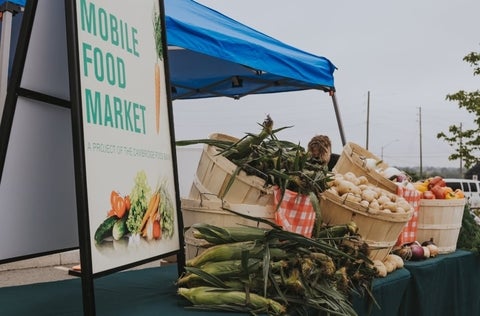Cambridge Food Bank: rethinking food programs
The Cambridge Food Bank reimagines what a food bank can be. Some may think food assistance programs like a food bank as the main way to address food insecurity, while others may recognize that it is a Band-Aid solution. While the Cambridge Food Bank also recognizes this, they go above and beyond the typical operations of a food bank to offer many unique programs to encourage the community to consume, grow, and learn about healthy food. Each of these initiatives try to connect with different elements of the food system along with connecting with food with dignity and humanity. On November 10th, 2022, students from the University of Waterloo’s GEOG 460 course went for a trip to the Cambridge Food Bank to learn about these opportunities from Fig, the Local Food Coordinator.

Fig, Local Food Coordinator
Fig is someone who everyone refers to as the mastermind of the operation. She is an example of someone going above and beyond in her role. She mentioned a story of going to a farm to volunteer her time in exchange for a reduced price on lettuce heads. All in all, Fig was very impressive, but we must also note that all the volunteers are doing whatever they can to improve food security. As Fig led us through the various facilities of the Cambridge Food Bank, she called on the workers we crossed paths with to speak about the work they do, whether that be coordinating a program, transporting the food or other tasks. Everyone we met left compassionate and hardworking impressions.

Fig, the Local Food Coordinator at the Cambridge Food Bank
Core values
We believe that access to nutritious food is a basic and fundamental human right.

Healthy People
The Cambridge Food Bank recognizes the health impacts of poverty and food insecurity, especially on low-income families who are often unable to afford the fresh foods and produce needed to maintain good health. Instead, they rely on cheap, filling, and high nutrient foods. The Cambridge Food Bank’s goal is to increase access to fresh and nutritious food.

Connected Community
The Cambridge Food Bank recognizes how social isolation impacts physical and mental health, accelerates aging, and reduces quality of life. They offer a holistic and broad range of nutrition and wellness programming, including a weekly community meal and the community kitchen and wellness hub where folks can share knowledge and skills while building social connections. While centered in food they are “more than a food bank.”

Environmental Sustainability
The Cambridge Food Banks has environmental commitments to reduce food waste through landfill diversion and food rescue. They partner with local farmers, gardeners, land stewards, and community groups to grow over 10,000 lbs of organic produce for their programs, which helps reduce greenhouse gases and our local carbon footprint.
These core values guide the Cambridge Food Banks programs and operations as Fig guides us through their facilities.
Challenges
The Cambridge Food Bank faces many challenges despite their many initiatives to engage the community and build a stronger food network. For example, they have disproportionately more donations during the Winter season of October-December than the rest of the year. This in of itself is not an issue, but they face near emptiness during the summer months, whereas more donations year-round would be more beneficial. Rising food costs create barriers to buying food for the food bank, impacting access and accessibility for those who rely on them. They also fight the stigma that “calories are more important than nutrition” for the food insecure by providing nutritious and culturally appropriate food for everyone. Fig noted that though they do support the community, in an ideal world the food bank would not exist, and people would have access to food themselves.
Facility Operations
Continuing through the facility, we saw the dry storage area which was receiving much needed replenishment due to the giving season between Thanksgiving and Christmas. So, if you forget to donate during the giving season, a summer donation could go very far. Moving forward, we learned that the distribution center was the heart of the food bank where perishable and non-perishable items are sorted and stored. As we continued through the building, we saw the processing area which was filled with friendly volunteers of all ages from high school students to anything above.
Programs

The Community Pantry
While the Community Pantry as an emergency food support is the first thing to come to mind when considering food banks, the Cambridge Food Bank takes it to a whole other level. Acting like a mini market, it gives patrons greater control to take items more useful to them. The quantity of the Food Basket depends on the number of people per household and may contain a “mix of canned, boxed, fresh, and frozen food,” along with baby food, formula, diapers, and female hygiene products (Cambridge Food Bank, 2022c).
When in need of emergency food, Cambridge and North Dumfries residents can acquire 5 days' worth of food up to 12 times a year (Cambridge Food Bank, 2022c). Fig explained that one of their main goals is to reduce barriers to food access. For example, people are meant to be screened for address and income, but the latter is often bypassed to make food more accessible. Also, their weekly hamper is available for those who are unable to provide proof of address.
Above all else, Cambridge Food Bank volunteers work hard to be welcoming and helpful to all patrons using the Community Pantry to help them select items suitable for their situations, families, and dietary needs, whether that by special diets, vegetarian options, food allergies, or religious dietary restrictions (Cambridge Food Bank, 2022c). The customer service and treatment helps to ensure a safe space and a dignified, individualized experience at the Community Pantry.
Youth and Children Program
The Cambridge Food Bank provides an array of counselling and support services in their Wellness Hub. A part of this hub, the Children and Youth Program, led by the energetic Youth Activator Coordinator, Vanessa, engages youth in the community. This entails providing programs about nutrition education, encouraging people to get into the kitchen, highlighting opportunities for socialization through food sharing, and getting a direct line of information about what the community wants. Vanessa ran all the school-based initiatives and was working on teaching valuable food literacy skills to students. She provided cooking classes at the Food Bank but was also always on the go to schools and other community events.
Food bank gardens
“From Field to Food Bank to Fork: Our gardens are about more than food. This is our community growing food for our community”

These gardens offer another opportunity to improve food literacy while fostering greater physical, mental, and spiritual health through building relationships and breaking down social barriers (Cambridge Food Bank, 2022d). Initiatives include:
- Grow-A-Row – this program gives a chance for gardeners to help feed their community by planting a row of fresh food to share with their neighbours in need
- Gleaning – means gathering unharvested food from gardens, fields, and fruit trees to simultaneously reduce food waste and increase the amount and availability of fresh food
- Feed More, Waste Less – reduces food waste through saving surplus food and food rescue to be cooked or preserved by volunteers in the food bank’s kitchen each week
Mobile Food Market
“In Your Neighborhood: Bringing fresh and affordable food to the neighbours of Cambridge and North Dumfries."
One highlight of the Cambridge Food Bank that really sets them apart is the Mobile Food Market. This is a fairly new initiative that brings the fresh produce market on the road with the goal of making it more affordable. Anyone is welcome to buy fresh produce from the Market at a price they can afford, meaning there is no pre-registration or screening required to support each other and folks before having to get to that desperate place of accessing the Community Pantry. The minimum cost is a subsidized flat rate of $5 for the produce, but if you can it is encouraged to give more as it helps the initiative to go further and supports those who are living on low income.
The program serves about 450 a week and operates out of the food bank itself, but also through the mobile program at nine locations around Cambridge and the North Dumfries region. The food bank arrives at these locations at the same time every week and sells produce baskets. About 75% of the food for the mobile market is bought by the food bank, so approximately 25% is donated. Each week the Market features a variety of fresh fruits and vegetables depending on what is currently in season (Cambridge Food Bank, 2022e).


Patrick, Mobile Food Market Coordinator
While sourcing local food is a priority, some food may be imported based on requests from the Market shoppers (Cambridge Food Bank, 2022e). For example, they try to promote inclusivity and diversity by sourcing food that meets cultural and dietary needs to cultivate long-term relationships.
Patrick, the Mobile Market Coordinator, encourages a positive experience at each market to engage the community and encourage them to come back each week. At these markets they also provide recipes to help build a stronger food network. The Cambridge Food Bank is a distribution and direct service center which positions themselves to build authentic and meaningful relationships.
Partnerships
We heard about companies such as Google which organize monthly volunteer dates as a giving back initiative which would be a great idea for any businesses in the Waterloo Region. Additionally, Fig spoke about the compost program which is a grant with the food bank and the compost council in Canada as they work together. We learned that the compost from here goes back up to the gardens to feed the soil that grows food. With the support of the community, the Cambridge Food Bank is able to invest in local farmers, such as Fertile Grounds Farm, to grow food for the Mobile Market.
“We believe that investing in the community, the people we serve, and our environment will lead to better lives.”
Impact

Cambridge Food Bank, 2022
It was so uplifting to see how much support is coming from this center not only in terms of the amount of people being supported, but also how much community is being created in this process.
Become A Volunteer or Donate Food/Funds or Join a Program
References
Cambridge Food Bank. (2022a). About: Core Values. Retrieved from https://cambridgefoodbank.org/core-values/
Cambridge Food Bank. (2022b). About: Meet Our Team. Retrieved from https://cambridgefoodbank.org/our-team/
Cambridge Food Bank. (2022c). Programs: Community Pantry. Retrieved from https://cambridgefoodbank.org/community-pantry/
Cambridge Food Bank. (2022d). Programs: Food Bank Gardens. Retrieved from https://cambridgefoodbank.org/food-bank-gardens/
Cambridge Food Bank. (2022e). Programs: Mobile Food Market. Retrieved from https://cambridgefoodbank.org/mobile-food-market/
Cambridge Food Bank. (2022f). Programs: Wellness Hub. Retrieved from https://cambridgefoodbank.org/supports-for-people/




